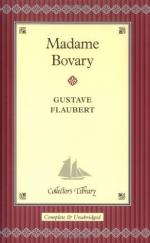|
This section contains 5,264 words (approx. 18 pages at 300 words per page) |

|
SOURCE: "Economics as Lure in Madame Bovary," in Money: Lure, Lore, and Literature, edited by John Louis DiGaetani, Greenwood Press, 1994, pp. 163-74.
In the following essay, Reynaud examines the economic metaphors in Flaubert's Madame Bovary that relate to debt, borrowing, investing, and an entire system contaminated by fortune.
To read Madame Bovary as a novel dealing with political economics, to see how economic metaphors are disseminated in the narrative, seems more to pertain to the category of wager (gageure) than to rest on a certainty best symbolized by the gold exchange standard (gage-or) as the full convertibility of currency into gold. The play on words (better rendered in French) can appear rather far-fetched and even unreliable, but it will subsequently be justified within the perspective of this chapter, in which falsity is certainly the surest value upon which to rely. When Flaubert's novel was published, the system of...
|
This section contains 5,264 words (approx. 18 pages at 300 words per page) |

|


